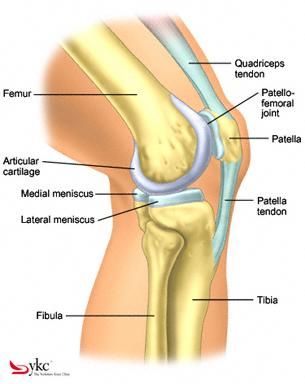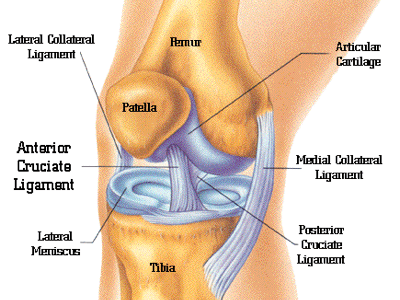Knee pain
What causes knee pain?
Knee pain can be caused by a number of factors, but to understand how the knee can get injured we need to look at it's structure (see images).
As you can see the knee is a straightforward hinge joint. Therefore, it's main purpose is to straighten (extend) and bend (flex) the lower leg; it also has some rotational movement available when the knee is bent, but this is limited.
This 'simple' range of movement means the joint is vulnerable to any excessive rotation and side impact, as it has limited capacity to deal with these forces. It is also heavily influenced (in terms of load and therefore wear) by the ankle and foot. If the ankle or foot aren't functioning properly, this can lead to excessive loading on the outside, or inside of the knee joint and cause abnormal wear and tear.

Common sources of knee pain
Patella tendonitis
From the image across you can see the patella (kneecap) tendon, this can get inflamed and sore if the muscles at the front of the leg (quadriceps) exert too much force on it. What happens is the tendon attachment starts to tear / separate from the lower leg bone (tibia) it attaches to. This is known as patella tendonitis. Symptoms include pain and swelling under the kneecap
Meniscus tear
Another common source of pain can be a tear or damage to the meniscus in the joint. This can happen over time through general wear and tear, or through an impact injury to the side of the knee. Symptoms of meniscus injury are pain when fully straightening (extending), or fully bending (flexing) the knee joint.
Ligament damage
As you can see from the second image (across), there are 2 types of ligaments in the knee; the cruciate and collateral ligaments. The purpose of the ligaments is to stabilise the joint and provide the limits to it's 'safe' end range, so the joint is not damaged during flexion and extension.

It is common for damage to occur to both sets of ligaments at the same time. Again, this usually happens due to excessive rotation, or side impact. However, damage can also occur due to excessive extension/flexion. In these circumstances the ligaments can get stretched and / or torn leading to instability in the knee joint.
Symptoms of ligament damage include; swelling all around the knee joint, as well pain and instability during exercise. Inflammation can recede on rest, however, will reoccur as soon as the knee is used again.
Runner's Knee (iliotibial band syndrome)
If the muscles that attach into the knee are imbalanced, this can cause the kneecap to 'maltrack'; creating friction with the iliotibial band. It can also put excessive strain on the knee joint, which in turn can lead to inflammation. Symptoms of Runner's Knee are pain on the upper outside edge of the kneecap which recedes after resting from exercise for a few days, but returns on exercise. Running on uneven ground may also increase, or speed-up the symptoms.
Suitable therapies
It is important to get a diagnosis from your doctor as soon as possible, as in some cases where the damage is significant surgery may be required. Where the damage is not too severe physiotherapy may be offered to aide recovery. Massage, Taping, Movement Coaching and Acupuncture can also be used to help reduce swelling and for addressing muscle imbalances. If your injury is sports related then you can use Sports Therapy for rehabilitation. However, if you have undiagnosed knee pain and are thinking about using Complementary Therapies to help manage it, make sure you use an experienced therapist who is trained to assess the knee joint, as certain therapies / techniques may be contraindicated.
Self Management techniques
As already mentioned it is important to get a proper diagnosis and this is especially important before trying any self management. Where there is muscular weakness, runner's knee, or low level instability in the knee joint there are exercises which can help; however, it is always important to get professional advice first.
